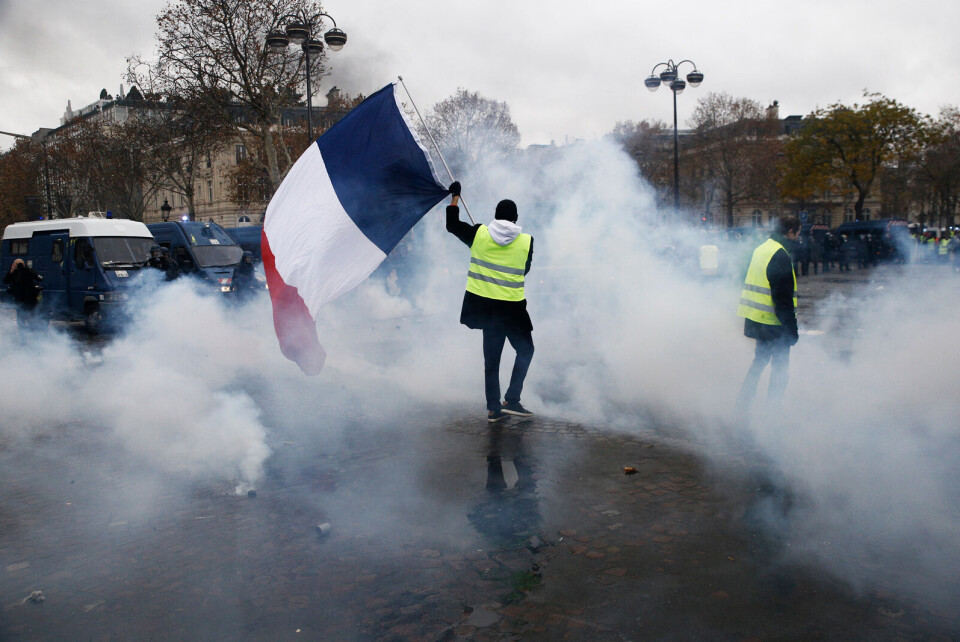-
French farmer protests: where roadblocks and disruption are restarting
A major demonstration is planned for Paris as well as a ‘siege’ of Toulouse
-
Snow causes transport havoc across France - more expected tonight
More than 1,000 kilometres of traffic jams were recorded in the Paris area. Some roads are closed and flights, buses and trains impacted, with six deaths recorded
-
French court hands out prison sentences and damages in Brigitte Macron cyberbullying cases
Ten people were found guilty over online comments claiming the president wife is a transexual woman and paedophile
Who are France's 'gilets jaunes'?
A core group of the 'yellow vest' protesters are refusing to let diminished turnout deter them as they continue to demonstrate, mainly in Paris

The gilet jaunes protests once attracted hundreds of thousands, but the third anniversary of the movement’s launch in late November saw some 1,800 take to the streets of the capital.
Some former participants have been put off by clashes between police and protesters, while others have a sense of resignation, with fuel prices, the original grievance, higher than ever today. Covid has also taken over as the main focus of concern.
However, those remaining have no plans to hang up their yellow vests any time soon.
“I’ve been here since the beginning, and I’ll be here until the end,” said Paris-based protester Perrine, who declined to give her last name due to safety concerns. “My passion hasn’t changed – I’m loyal. I fully support the gilets jaunes,” she said.
The group formed after a fuel tax rise was proposed to combat climate change in late 2018.
Citizens united behind a petition created by a businesswoman to demand the measure be abandoned. It soon became a focus for all kinds of grievances against the status quo for those who felt they were not listened to by politicians.
287,710 gilet jaunes on the streets for their first 'act'
The first ‘act’ on November 17 – a term for the recurring Saturday protests – saw 287,710 demonstrators take to the streets and roundabouts.
With no single leader, crowds were a disparate mix of far-right and left activists and lower middle-class families, with the typical supporter owning their home and a car but with a tight budget at the end of the month.
All of them sported the highvis yellow vests drivers must have in their cars. The movement sustained momentum countrywide even after the fuel price rise was scrapped and a state of economic and social emergency was declared.
Although some initial goals were achieved, the gilets jaunes still maintain their broader discontent towards President Macron and his government.
Members are now fighting, in the words of protest organiser Nejeh Ben Farhat, “for more social justice, more fiscal justice, and more participatory democracy.
“Above all, to say to our government that we will no longer accept the advantages and privileges it grants itself.”
Since July, this has meant joining demonstrations calling for the discontinuation of the health pass. According to Michel, a gilet jaune from Paris, they have always been engaged in a battle for equality: “Equal rights, economic and social equality… the fight that is being led against the health pass is exactly the same fight as ours.”
This is not the first time their interests have aligned with those of other movements. They have often joined demonstrations of workers’ unions and environmental organisations.
The movement has diverse motivations, according to Tristan, another Paris-based demonstrator. “The gilets jaunes are more and more different – there are some who support Le Pen, there are communists, there are Trotskyists, there are some with the [far-right youth movement] Génération Nation, others are unaligned.”
That may be why the movement’s once-widespread presence has proved unsustainable.
“What brings these people together is the fact they are against representation,” said Sciences Po politics researcher Ömer Faruk Metin.
“Because they are against representation, this harmed the process of institutionalisation within the movement itself.”
Others cite the protests’ recurring violent outbreaks as part of the reason for the decline.
Demonstrations have seen hundreds of injuries to protesters, police and journalists
During the first demonstrations in Paris, shops, restaurants and vehicles were vandalised and set on fire and monuments, including the Arc de Triomphe, were defaced.
In March 2019, heavy looting forced police to ban protests on the Champs-Elysées. Anarchist ‘black blocs’, who often infiltrate the demonstrations, have been deemed partly to blame, and criminal trials for some of the looters are under way.
However, Mr Farhat said the police should also be held accountable for excessive use of force, citing this as a deterrent for people who would otherwise attend the protests. “We have suffered repression on the part of the government, which no other social movement has suffered since the start of the Fifth Republic,” he said.
Tristan said: “Some have been intimidated into stopping. Others, like me, have been harassed and have been political prisoners, but these are reasons I continue to participate. I want to show the gilets jaunes’ power.”
The French will soon be able to express their views at the polls.
“It’s unfortunate, but I think Macron will be re-elected,” said Michel. “I don’t have a lot of hope for 2022. It will not settle the problems we are heading towards – a social and economic crisis, and misery across Europe.”
Others doubt they have a future. “I don’t see that they can come back easily, because people see they don’t know what to do next,” said Mr Metin.
However, it is clear that many are here for the long haul.
“I am a gilet jaune to the core,” said Tristan. “I’ll always be there next Saturday.”
























